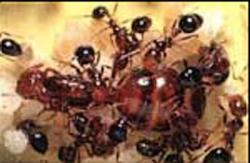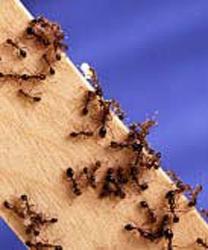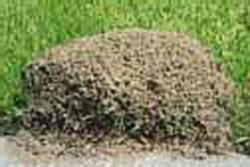
|
 Red Fire Ants – Beware!


The Queen Fire ant is responsible for laying thousands of eggs. The number of
males is low, because only one male is needed for the entire reproduction process.
|
Ants are among the most numerous
of all the insects. The Fire ant,
(Solenopsis invicta) in particular is
the most common specie in Belize
and all parts of the world. It is considered
the most aggressive. Found
in most parts of Belize, there’s no
escaping these insects that roam the
forest floors searching for food.
There is a great diversity among ants
and their behaviors. They range in
size from two to about 25 millimeters (about 0.08 to 1 inch). Their color
may vary, most are red or black, but
other colors can also be seen.

Fire Ant Queen Surrounded by
Workers, Brood and Eggs.
|
Fire ants are symmetrical along
the body, meaning that the left part is
a mirror image of the right. They have
hardened exoskeletons, meaning that
they have no bones or internal supporting
tissues, but tough protective
layer for support and protection. They
breathe through their trachea and
their bodies can be classified into
three major parts: head, thorax and
abdomen. They have three pairs of
legs, and a pair of antennae that seems
to be invisible to the naked eye attached
to the head. Just like other
ants, the worker and soldier ants are
sterile females. The queen is responsible
for laying thousands of eggs. The
number of males is low, because only
one male is needed for the entire reproduction
process. Contrary to what
most people believe, the fire ant does
not just ‘bite’. They use their jaws to
anchor themselves and then, like a
bee or wasp, inject venom using a
sting at the tip of their abdomen. Using
their strong mandibles to attach
themselves to the victim’s flesh, they
can sting many times continuously.
Fire ants are one of the most successful
groups of insects in the animal
kingdom and are of particular interest
because they are a social insect
and form highly organized colonies

Widely disliked for their venomous,
painful stings, Fire ants have spread
across much of the country. Using
their strong mandibles to attach themselves
to the victim’s flesh, the red
fire ants can sting many times continuously.
|
or nests, sometimes consisting
of millions of individuals. Colonies
of invasive ant species will sometimes
work together and form super colonies,
spanning a very wide area of
land. Ant colonies are sometimes
described as super organisms because
they appear to operate as a
single entity. They have colonized
almost every landmass on Earth and
can constitute up to 15% of the total
animal biomass of a tropical
rainforest. As of 2006, there are
11,844 known ant species, most of
which reside in hot climates.
The lifespan of Fire ant workers
depend on their size. Minor workers
may live 30 to 60 days, media workers
60 to 90 days, major workers 90
to 180 days, and queens may live two
to six years. Complete lifecycle
from egg to adult takes between 22
and 38 days. The life cycle starts
when the queen mates with a male.

Widely disliked for their venomous,
painful stings, Fire ants have spread
across much of the country. Using
their strong mandibles to attach themselves
to the victim’s flesh, the red
fire ants can sting many times continuously |
The sexual male and female workers
have wings which allow new colonies
to disperse. The sexuals (known
as alates) fly into the air, sometimes
as high as 100 feet (30 meter) in a
large cloud and mate on the wing.
After inseminating the female with
sperm, the male dies. The female
then searches for a suitable nest site,
drops her wings and begins laying
eggs. Until her first batch of workers
(known as minums) are able to
forage for her, the queen survives on
internal fat stores and energy gained
from the breakdown of her now useless
flight muscles. This first group
of approximately 10 eggs takes
around 10 days to hatch. It is approximately
20 more days before the larvae
become worker ants. The first
worker ants are very small in size.
Gradually, the size and number of
workers increases as the queen is fed
with more nutrients.
There are four different classes of
Fire ants that live in a colony: winged
males, winged females, workers, and
queens. The Fire ant is unique in that
it forms colonies with multiple
queens. The Fire ant’s life is extremely
organized. Every ant has a
job to do. They go about doing their
job day after day, without stopping.
The worker’s job is to keep the larvae,
pupae, and queen clean. Cleanliness
appears to be extremely important
to the ants. They are constantly
cleaning the larvae, the pupae, the queen, and the colony. The
workers also forge to find food for
the colony. The Fire ant has two stomachs,
one for its own food supply, and
one for the colony’s food supply. The
second stomach is called a crop.
They feed mostly on other insects but
can attack small birds and other invertebrates.

Fire ants build characteristic mounds that
are low and squat, up to 40cm high and
half to three quarters of a metre in diameter.
The mounds are built in open
areas, including lawns and pastures. |
Flea larvae, chinch
bugs, cockroach eggs, ticks, and
other insects are also on their menu.
They especially like to eat soft fruits,
but the most fascinating thing about
them is that they can carry food
twenty times their body weight; truly
fascinating.
The winged females go on mating
flights and found new colonies. The
male’s only job is to mate with the
quite a problem. Fire ants interrupt
farming production because they construct
their colonies on precious farmland.  They also like to make their
mounds in sunny areas. Therefore, pastures
are heavily infested. The control
of these ants in pastures, hay fields, and
recreational turf grass is at least a $28
dollar per acre expense. Livestock and
poultry can be injured and even killed
by stings. Small birds such as baby quail
are fair game to the expanding colony.
Farm machinery is often damaged by
running over a mound. Fire ants can
quickly strip fruit trees of their fruit. On
a positive note, experts believe that they
are essential to the tropical forest ecosystem
as they turn the soil and redistribute
nutrients. They also clean the ecosystems
by removing small dead or dying
creatures which hastens decomposition.
Although small, they do have a
powerful bite, so don’t mess with them
and watch your step!
.
They also like to make their
mounds in sunny areas. Therefore, pastures
are heavily infested. The control
of these ants in pastures, hay fields, and
recreational turf grass is at least a $28
dollar per acre expense. Livestock and
poultry can be injured and even killed
by stings. Small birds such as baby quail
are fair game to the expanding colony.
Farm machinery is often damaged by
running over a mound. Fire ants can
quickly strip fruit trees of their fruit. On
a positive note, experts believe that they
are essential to the tropical forest ecosystem
as they turn the soil and redistribute
nutrients. They also clean the ecosystems
by removing small dead or dying
creatures which hastens decomposition.
Although small, they do have a
powerful bite, so don’t mess with them
and watch your step!
.
Click here to return to the main page for Caribbean Critters
|








